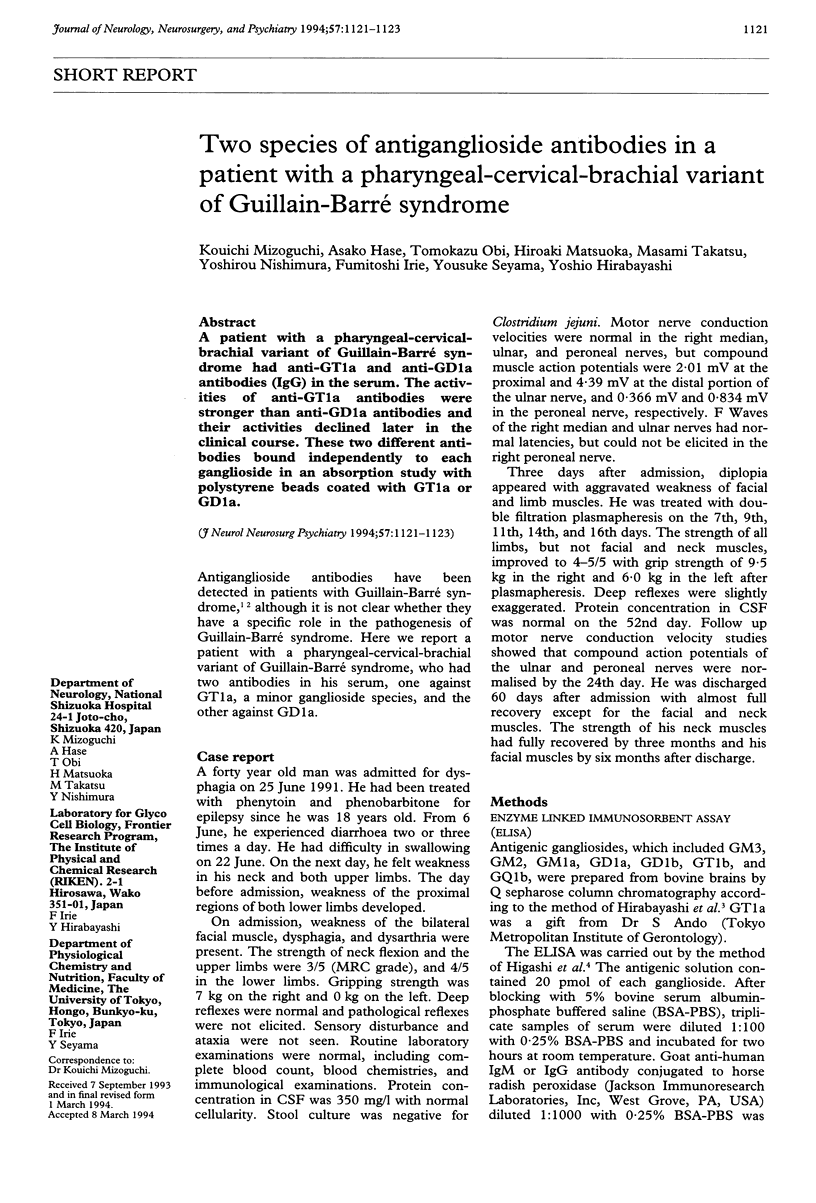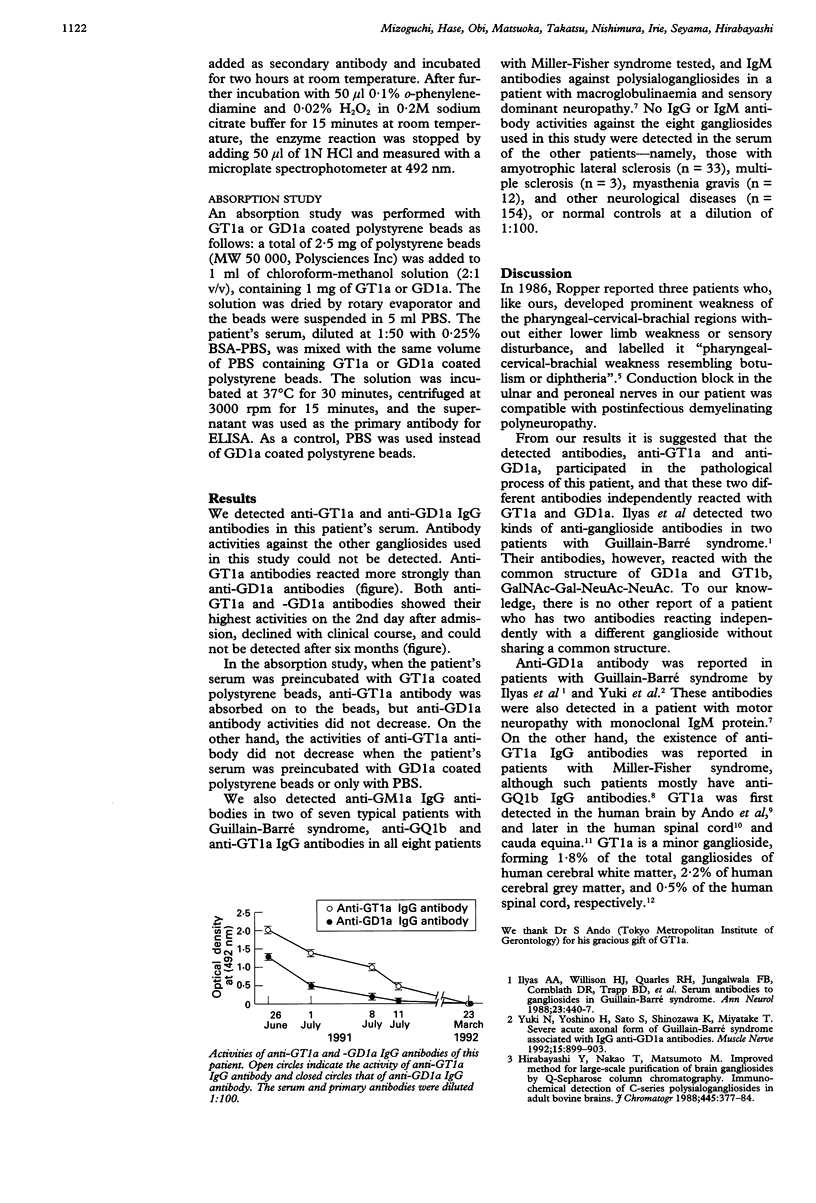Abstract
A patient with a pharyngeal-cervical-brachial variant of Guillain-Barré syndrome had anti-GT1a and anti-GD1a antibodies (IgG) in the serum. The activities of anti-GT1a antibodies were stronger than anti-GD1a antibodies and their activities declined later in the clinical course. These two different antibodies bound independently to each ganglioside in an absorption study with polystyrene beads coated with GT1a or GD1a.
Full text
PDF


Selected References
These references are in PubMed. This may not be the complete list of references from this article.
- Ando S., Yu R. K. Isolation and characterization of a novel trisialoganglioside, GT1a, from human brain. J Biol Chem. 1977 Sep 25;252(18):6247–6250. [PubMed] [Google Scholar]
- Bollensen E., Schipper H. I., Steck A. J. Motor neuropathy with activity of monoclonal IgM antibody to GD1a ganglioside. J Neurol. 1989 Sep;236(6):353–355. doi: 10.1007/BF00314380. [DOI] [PubMed] [Google Scholar]
- Chiba A., Kusunoki S., Obata H., Machinami R., Kanazawa I. Serum anti-GQ1b IgG antibody is associated with ophthalmoplegia in Miller Fisher syndrome and Guillain-Barré syndrome: clinical and immunohistochemical studies. Neurology. 1993 Oct;43(10):1911–1917. doi: 10.1212/wnl.43.10.1911. [DOI] [PubMed] [Google Scholar]
- Dawson G., Stefansson K. Gangliosides of human spinal cord: aberrant composition of cords from patients with amyotrophic lateral sclerosis. J Neurosci Res. 1984;12(2-3):213–220. doi: 10.1002/jnr.490120209. [DOI] [PubMed] [Google Scholar]
- Higashi H., Ikuta K., Ueda S., Kato S., Hirabayashi Y., Matsumoto M., Naiki M. Characterization of N-glycolyneuraminic acid-containing glycosphingolipids from a Marek's disease lymphoma-derived chicken cell line, MSB1, as tumor-associated heterophile Hanganutziu-Deicher antigens. J Biochem. 1984 Mar;95(3):785–794. doi: 10.1093/oxfordjournals.jbchem.a134670. [DOI] [PubMed] [Google Scholar]
- Hirabayashi Y., Nakao T., Matsumoto M., Obata K., Ando S. Improved method for large-scale purification of brain gangliosides by Q-sepharose column chromatography. Immunochemical detection of C-series polysialogangliosides in adult bovine brains. J Chromatogr. 1988 Jul 22;445(2):377–384. doi: 10.1016/s0021-9673(01)84550-7. [DOI] [PubMed] [Google Scholar]
- Ilyas A. A., Willison H. J., Quarles R. H., Jungalwala F. B., Cornblath D. R., Trapp B. D., Griffin D. E., Griffin J. W., McKhann G. M. Serum antibodies to gangliosides in Guillain-Barré syndrome. Ann Neurol. 1988 May;23(5):440–447. doi: 10.1002/ana.410230503. [DOI] [PubMed] [Google Scholar]
- Obi T., Kusunoki S., Takatsu M., Mizoguchi K., Nishimura Y. IgM M-protein in a patient with sensory-dominant neuropathy binds preferentially to polysialogangliosides. Acta Neurol Scand. 1992 Aug;86(2):215–218. doi: 10.1111/j.1600-0404.1992.tb05069.x. [DOI] [PubMed] [Google Scholar]
- Ropper A. H. Unusual clinical variants and signs in Guillain-Barré syndrome. Arch Neurol. 1986 Nov;43(11):1150–1152. doi: 10.1001/archneur.1986.00520110044012. [DOI] [PubMed] [Google Scholar]
- Ueno K., Ando S., Yu R. K. Gangliosides of human, cat, and rabbit spinal cords and cord myelin. J Lipid Res. 1978 Sep;19(7):863–871. [PubMed] [Google Scholar]
- Yuki N., Yoshino H., Sato S., Shinozawa K., Miyatake T. Severe acute axonal form of Guillain-Barré syndrome associated with IgG anti-GD1a antibodies. Muscle Nerve. 1992 Aug;15(8):899–903. doi: 10.1002/mus.880150806. [DOI] [PubMed] [Google Scholar]


